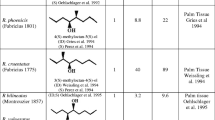Abstract
We attempted to suppress a population ofScolytus multistriatus (Marsham), the principal vector of Dutch elm disease, by trapping flying beetles on sticky traps baited with synthetic pheromone. The estimated catch on 421 traps distributed throughout a 1-km2 plot in Detroit, Michigan, was nearly 1 million beetles. Because an estimated 5 million beetles emerged in the plot during the study period, we conclude that this preliminary trapping study had no appreciable effect on suppressing the population. Studies that employ improved materials and techniques are continuing.
Similar content being viewed by others
References
Bedard, W.D., Tilden, P.E., Wood, D.L., Silverstein, R.M., Brownlee, R.G. andRodin, J.O. 1969. Western pine beetle: Field response to its sex pheromone and a synergistic host terpene, myrcene.Science 164:1284–1285.
Collins, Donald L. 1938. Feeding habits ofScolytus multistriatus Marsham with reference to the Dutch elm disease.J. Econ. Entomol. 31:196–200.
Meyer, H.J., andNorris, D.M. 1967. Behavioral responses byScolytus multistriatus (Coleoptera: Scolytidae) to host-(Ulmus) and beetle-associated chemotactic stimuli.Ann. Entomol. Soc. Am. 60:642–647.
Neely, Dan. 1970. Dutch elm disease symptom progression.Plant Dis. Rep. 54(2):127–129.
Parker, K.G., Readio, P.A., Tyler, L.J., andCollins, D.L. 1941. Transmission of the Dutch elm disease pathogen byScolytus multistriatus and the development of infection.Phytopathology 31:657–663.
Peacock, J.W., Lincoln, A.C., Simeone, J.B., andSilverstein, R.M. 1971. Attraction ofScotylus multistriatus (Coleoptera: Scolytidae) to a virgin-female-produced pheromone in the field.Ann. Entomol. Soc. Am. 64:1143–1149.
Pearce, G.T., Gore, W.E., Silverstein, R.M., Peacock, J.W., Cuthbert, R.A., Lanier, G.N., andSimeone, J.B. 1975. Chemical attractants for the smaller European elm bark beetle,Scolytus multistriatus (Coleoptera: Scolytidae).J. Chem. Ecol. 1:115–124.
Wallace, P. 1940. Notes on the smaller European elm bark beetle(Scotylus multistriatus Marsham).Conn. Agric. Stn. Bull. 434:293–311.
Wolfenbarger, D.O., andJones, T.H. 1943. Intensity of attacks byScolytus multistriatus at distances from dispersion and convergence points.J. Econ. Entomol. 36:299–402.
Author information
Authors and Affiliations
Rights and permissions
About this article
Cite this article
Cuthbert, R.A., Peacock, J.W. & Cannon, W.N. An estimate of the effectiveness of pheromone-baited traps for the suppression ofScolytus multistriatus (Coleoptera: Scolytidae). J Chem Ecol 3, 527–537 (1977). https://doi.org/10.1007/BF00989074
Received:
Revised:
Issue Date:
DOI: https://doi.org/10.1007/BF00989074




